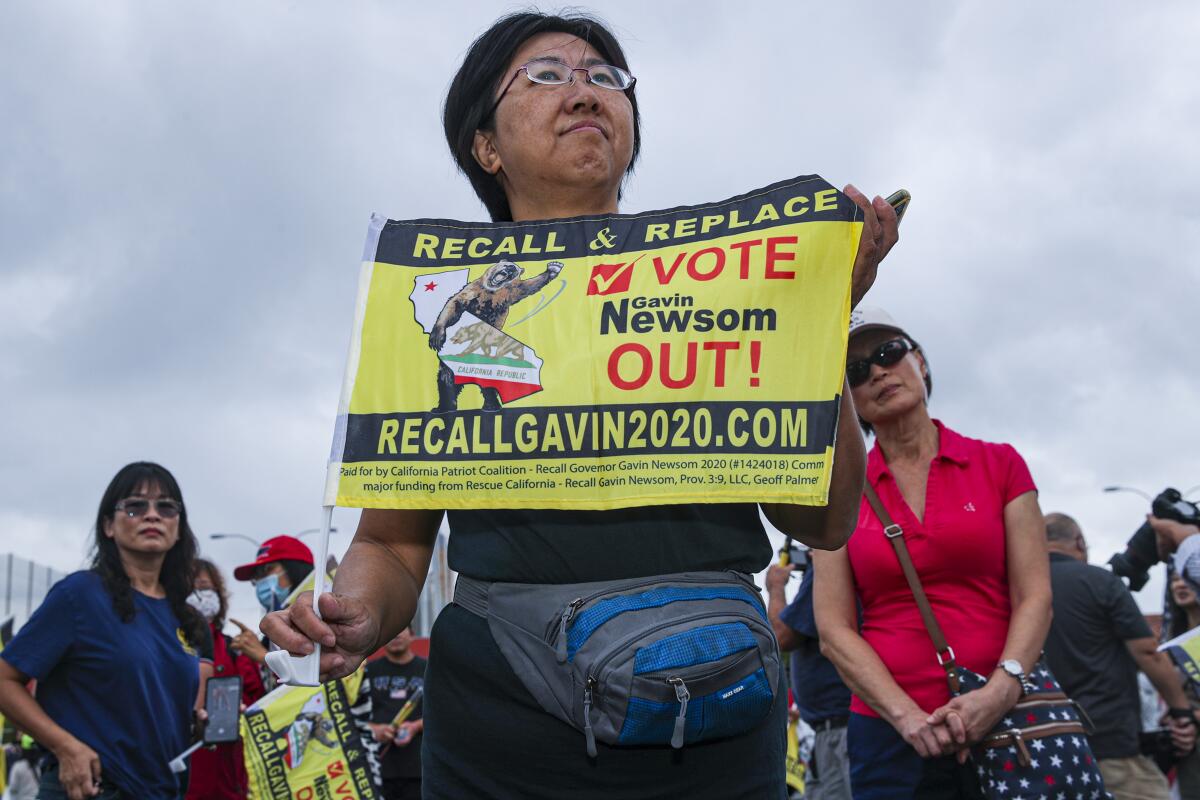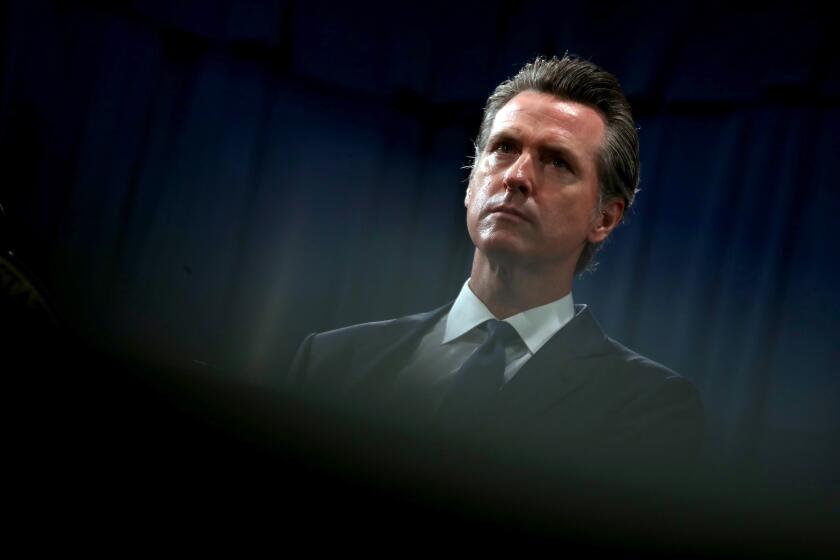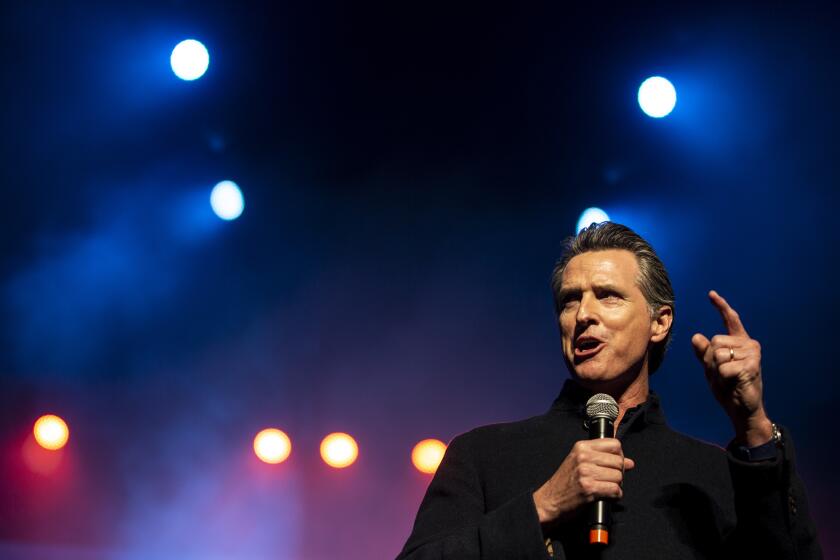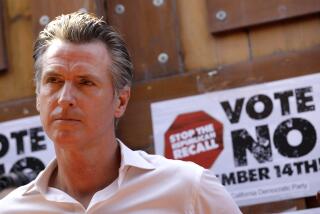Inside the social media war that could turn the California recall

In their social media campaign to remove Gov. Gavin Newsom, recall supporters are blaming him for a wide variety of ills, each advertisement targeted to specific voters based on their demographics and interests.
From the drought to gas prices to wildfires to homelessness, pro-recall social media ads are seeking to tap into anxieties among Californians that go beyond pandemic policies.
“If Gavin Newsom wins, be prepared to have your water shut off,” says a Facebook ad by the pro-recall group Rescue California.
Another ad claims that Newsom has invited the world’s homeless to come to California.
“We want someone to blame for all these things that are beyond our control, “ said Sacramento State University political science professor Kim L. Nalder, “and the governor is at the top of the structure of state government.”
Social media advertising has taken on outsized proportions during the recall effort, largely because of the compressed schedule of the campaign and the challenges recall proponents face in quickly raising money to pay for television advertising in key markets statewide.
The attempted recall of Gov. Gavin Newsom will go before voters on Sept. 14. Here are the details.
Anne Hyde Dunsmore, campaign manager for Rescue California, said social media ads also are more effective because they can be “micro targeted” to individual voters based on age, ethnicity, residency and interests. The water advertisements are going to people in the Central Valley and the homeless ads to urban areas, she said.
“They are are also way cheaper” than television and radio ads, she said. “You are talking about taking off a few zeros.”
Menlo College political science professor Melissa R. Michelson agreed that social media ads were particularly potent, not just because they can be targeted but also because social media users tend to be a captive audience.
“People are consuming social media quite often on their phones, flipping through while waiting in line for something or when they have a spare moment,” she said. “So you tend to get eyeballs on things in a different way. ... You are looking to be distracted.”
Newsom, to be sure, is also using social media to spur Democrats to vote.
He has more money to spend than recall supporters, and his Facebook ads portray the recall effort as an attempted Republican coup backed by supporters of former President Trump. The ads suggest that the lives of Californians are at stake because many of his proposed replacements would end vaccine mandates.
Before the recall election got underway, polling showed substantial approval of Newsom’s actions as governor, Nalder said. Michelson agreed, but noted that former New York Gov. Andrew Cuomo, forced to resign after multiple sexual harassment allegations, also was highly popular just a short time ago.
Discontent with the status quo could spur voters to eject Newsom, even if he isn’t directly to blame for the ills that plague the state, they said.
“Voting to keep the guy is not nearly as stimulating as the idea of throwing him out if you are angry,” Nalder said.
Polls have suggested it will be a tight election that will be decided by turnout. The Sept. 14 vote is the second recall attempt of a governor in two decades.
Voters ousted Gov. Gray Davis in 2003 during the last gubernatorial recall and replaced him with Arnold Schwarzenegger. Newsom, though, has some advantages that Davis lacked.
He was elected by a higher margin than Davis and does not face a well-known, charismatic movie star with wide name recognition.
Polls show the replacement candidate most likely to succeed Newsom would be Southern California conservative radio talk show host Larry Elder. One of Newsom’s Facebook ads includes a photograph of a smiling Elder with Trump.
In addition, all voters this time can cast their ballots by mail, which eases participation.
Still, political scientists say the possibility of recall should not be underestimated.
“If I had to bet money on it, I would bet he keeps his job,” said Nalder, executive directive of CalSpeaks Opinion Research and director of the Project for an Informed Electorate, which promotes civic education.
“But it is not a done deal,” she added, “and Democrats have been blind-sided by their own apathy in the past.”
Gov. Gavin Newsom said ‘the future belongs to California’ when he was elected. But the recall election puts his own future in doubt.
Michelson said it made sense that recall supporters were focusing on issues besides the pandemic. Masking and vaccines have become “polarizing,” she said. Newsom is more vulnerable on other problems confronting Californians, including homelessness, she said.
Facebook scoops up data on each user so the campaigns know their audience. They probably target not just Republicans but Independents and “weaker Democrats” who might be willing to vote against Newsom, she said.
“Maybe there are some Democrats who would normally vote Democratic and support the governor,” Michelson said. “But maybe even for them, if you get them thinking about homelessness and the housing crisis, they might say, ‘Yeah, that is really messed up. Why is it still so bad? Maybe the recall isn’t such a bad idea.’”
Rescue California’s Hyde Dunsmore noted that the recall efforts began before the pandemic, and voters should not be surprised that the ads were targeting Newsom on other issues.
“COVID just threw gasoline on the fire,” she said.
Most of the ballots already mailed come from Democratic regions, she said. So far, about 22% of white voters have cast ballots, 11% of Latinos, 17% of Asians and 18% of Black voters.
She said polls show that about 25% to 30% of Democrats favor recall, and Republicans are likely to want to vote in person. The stream of mail-in ballots has already begun to slow, a good sign for the pro-recall campaigns, she said.
Turnout is now at 18%, and “I think it is going to be close to 60%,” she said. The turnout for the recall of Davis was 61.2%.
“The trend sucks for Newsom,” she said.
California is strongly Democratic, an obstacle that recall forces have tried to confront in their social media ads by trying to tap into the discontent of specific voters.
When voters are confronted with pocketbook and public safety matters “it ceases to be partisan,” Hyde Dunsmore said. “It becomes personal.”
More to Read
Sign up for Essential California
The most important California stories and recommendations in your inbox every morning.
You may occasionally receive promotional content from the Los Angeles Times.













